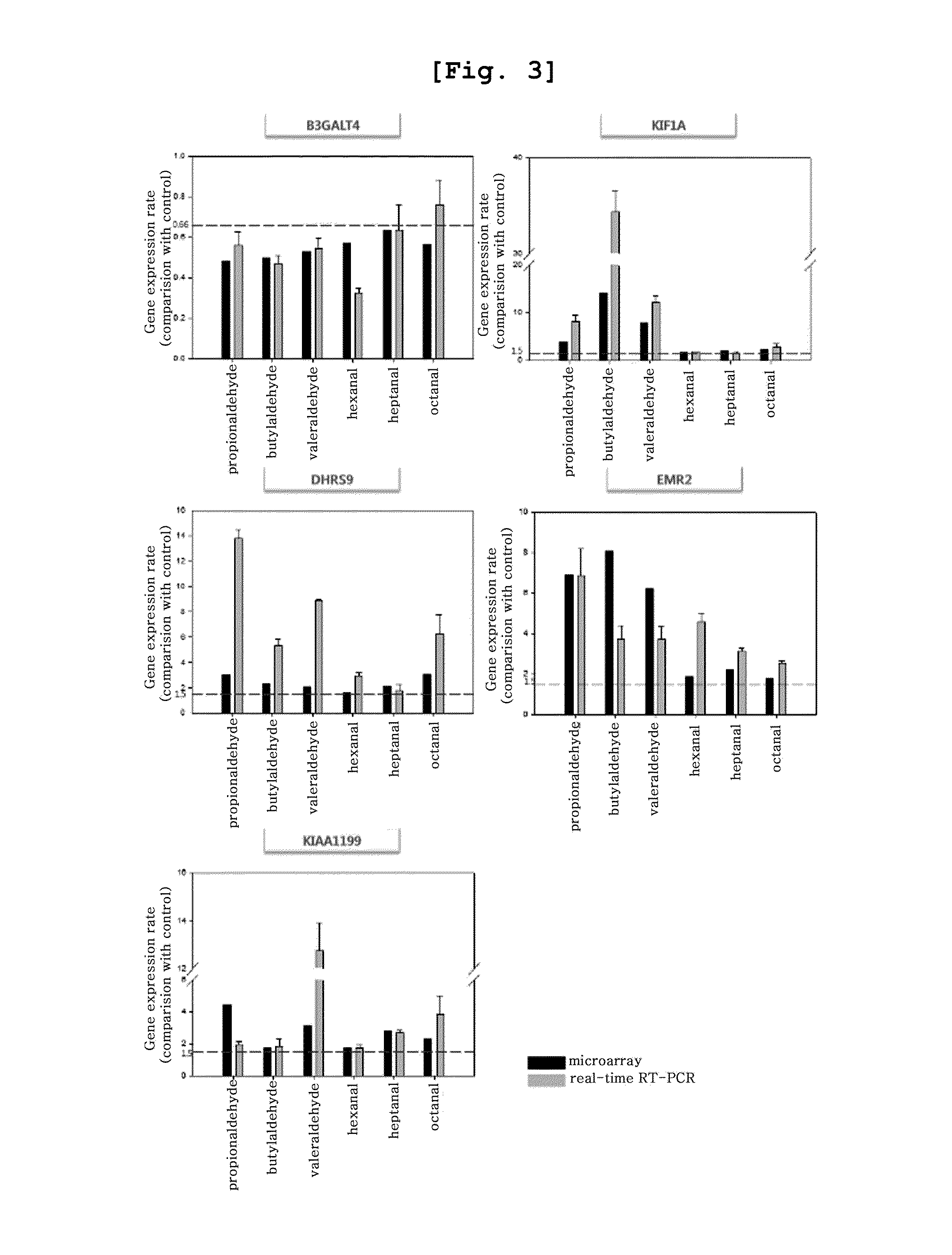Specific biomarker for identification of exposure to lower aliphatic saturated aldehydes and the method of identification using the same
a technology of aliphatic saturated aldehydes and biomarkers, which is applied in the field of specific biomarkers for the identification of exposure to lower aliphatic saturated aldehydes, can solve the problems of expensive equipment for analysis, nausea, vomiting, and indigestion, and achieve the effects of reducing the number of indigestion, and improving the sensitivity of indigestion
- Summary
- Abstract
- Description
- Claims
- Application Information
AI Technical Summary
Benefits of technology
Problems solved by technology
Method used
Image
Examples
example 1
Cell Culture and Chemical Treatment
Cell Culture
[0101]A549 cells (Korean Cell Line Bank), the human lung cancer tissue derived cell line, were cultured in 100 mm dish containing RPMI (Gibro-BRL, USA) supplemented with 10% FBS until the confluency reached 80%. The present inventors selected 6 kinds of lower aliphatic saturated aldehydes (propionaldehyde, butylaldehyde, valeraldehyde, hexanal, heptanal, and octanal) among many volatile organic compounds exposed in environment based on the previous studies and reports and then dissolved in DMSO (dimethyl sulfoxide). The concentration of vehicle was up to 0.1% in every experiment.
Cytotoxicity Test (MTT Assay) and Chemical Treatment
[0102]MTT assay was performed with A549 cell line according to the method of Mossman, et al (J. Immunol. Methods, 65, 55-63, 1983).
[0103]Particularly, the cells were distributed in 24-well plate (3.5×104 cells / well) containing RPMI (Gibro-BRL, USA) and then treated with lower aliphatic saturated aldehydes dis...
example 2
Microarray Experiment
Separation of Target RNA and Fluorescein Labeling
[0105]A549 cells were distributed in 6-well plate at the density of 25×104 cells / ml, to which lower aliphatic saturated aldehydes were treated for 48 hours at the concentrations determined in Example . Total RNA was extracted from the cells by using trizol reagent according to the manufacturer's protocol (Invitrogen life technologies, USA), followed by purification by using RNease mini kit (Qiagen, USA). Genomic DNA was eliminated by using RNase-free DNase set (Qiagen, USA) during the RNA purification. The amount of total RNA was measured with spectrophotometer, and the concentration was confirmed by ND-1000 Spectrophotometer (Thermo Fisher Scientific Inc., USA) and Agilent 2100 Bioanalyzer (Agilent).
Preparation of Labeled cDNA
[0106]For oligomicroarray analysis, cDNA was synthesized by using the total RNA obtained from the experimental group treated with lower aliphatic saturated aldehydes prepared in Example . ...
example 3
Quantitative Real-Time RT-PCR
[0111]To investigate and quantify the expressions of 5 different genes confirmed to be expressed specifically by lower aliphatic saturated aldehydes [Genebank accession number NM—003782 (B3GALT4, UDP-Gal:betaGlcNAc beta 1,3-galactosyltransferase, polypeptide 4; SEQ. ID. NO: 11), Genebank accession number NM—004321 (KIF1A, kinesin family member 1A; SEQ. ID. NO: 12), Genebank accession number NM—005771 (DHRS9, dehydrogenase / reductase (SDR family) member 9; SEQ. ID. NO: 13), Genebank accession number NM—013447 (EMR2, egf-like module containing, mucin-like, hormone receptor-like 2; SEQ. ID. NO: 14), and Genebank accession number NM—018689 (KIAA1199, KIAA1199; SEQ. ID. NO: 15)], selected in Example 2 among many genes demonstrating up- or down-regulation specifically by lower aliphatic saturated aldehydes, quantitative real-time RT-PCR was performed using My IQ real-time PCR machine (Bio-rad, USA).
[0112]Particularly, cDNA was synthesized by performing reverse ...
PUM
| Property | Measurement | Unit |
|---|---|---|
| Length | aaaaa | aaaaa |
| Fluorescence | aaaaa | aaaaa |
| Volatility | aaaaa | aaaaa |
Abstract
Description
Claims
Application Information
 Login to View More
Login to View More - R&D
- Intellectual Property
- Life Sciences
- Materials
- Tech Scout
- Unparalleled Data Quality
- Higher Quality Content
- 60% Fewer Hallucinations
Browse by: Latest US Patents, China's latest patents, Technical Efficacy Thesaurus, Application Domain, Technology Topic, Popular Technical Reports.
© 2025 PatSnap. All rights reserved.Legal|Privacy policy|Modern Slavery Act Transparency Statement|Sitemap|About US| Contact US: help@patsnap.com



